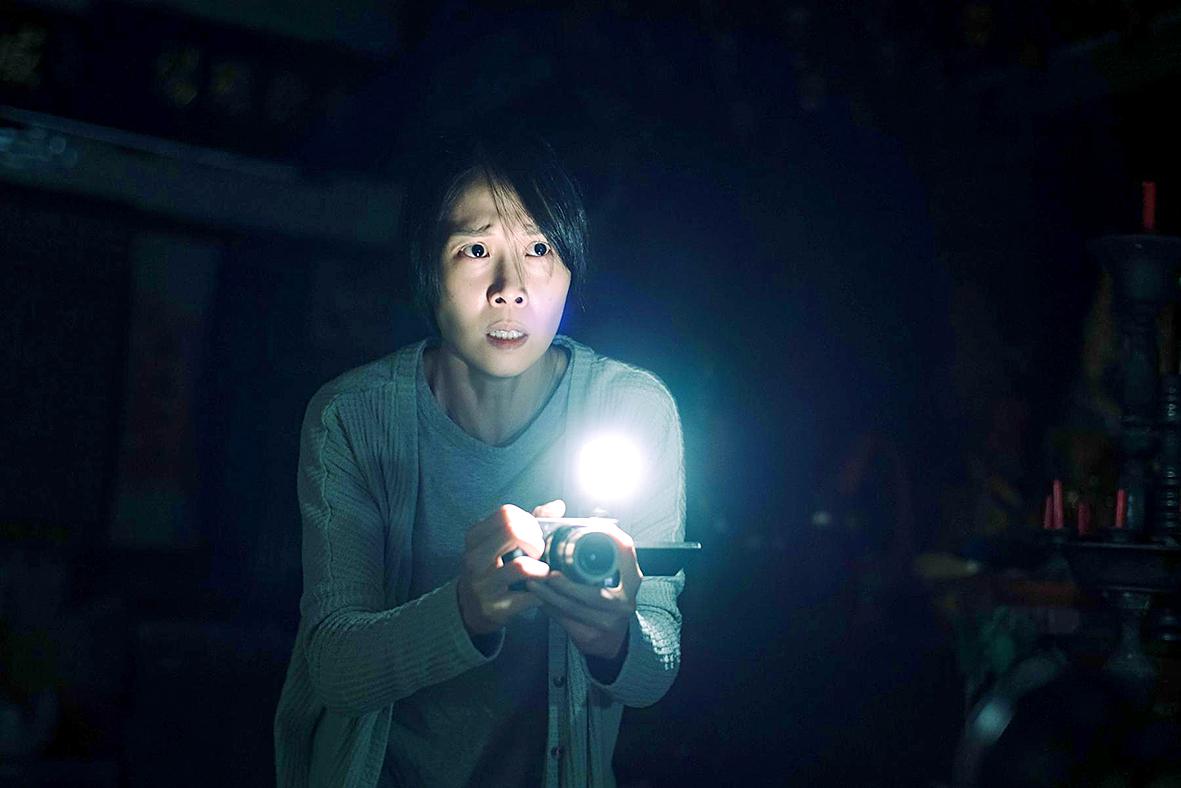Tragic protagonist Ruo-nan (Tsai Hsuan-yen, 蔡亘晏) asks the audience to memorize a symbol and repeat an ominous chant in the opening scene of Incantation (咒). It’s hard to resist the instructions whether you believe in folk religion or not, especially when she adds that reciting it silently works too.
The interactive element is not just a gimmick. It plays an unexpected part in the plot later on. Unfortunately, it is the only intriguing part of the film, which lacks a compelling story to ground the suspense. Incantation is mostly a run-of-the-mill found-footage horror flick that relies on hackneyed scare tactics, gore and stereotypical characters who arouse little sympathy.
The market for horror remains strong seven years after the overwhelming success of The Tag-Along (紅衣小女孩). Incantation, which explores the “uncharted territory” of local cults, touts itself as the “scariest Taiwanese film ever made.”

Photo courtesy of Activator Marketing Corp
This hype helped the film enjoy immense box office success, earning a nation-topping NT$23 million over its first three days in theaters. However, the devices and elements of this genre are getting a bit old, and every film seems to use more or less the same imagery and style choices. What’s really needed is a fresh and gripping tale, but Incantation fails to live up to its promise.
Horror films are not supposed to make complete sense, but in what world can someone snatch her daughter from child protection services, and in front of the police no less, and later bring her to hospital horribly malnourished and covered with putrid sores and syringe marks without any consequences? Even if poor Duoduo (Huang Hsin-ting, 黃歆庭) is really cursed, nobody questions Ruo-nan’s behavior or parenting. She’s even allowed to roam around the facilities where she causes even more harm.
This is just one of many inconsistencies that arise throughout the Incantation, starting with the tired premise. Six years prior to the film’s beginning, a pregnant Ruo-nan, her boyfriend A-tung and his brother A-yuan are running one of those “ghostbusters” YouTube channels that seem to appear in every other horror film these days. Their latest mission is to infiltrate a religious ritual hosted annually by the family of A-tung and A-yuan deep in the mountains. They also plan to sneak into a forbidden cave.

Photo courtesy of Activator Marketing Corp
Of course, they act recklessly, defacing the temple’s gate with graffiti while smashing doors and sacred objects. It turns out that the clan is part of an evil cult that originated in Southeast Asia, and they have to carry out this grim ritual every year to prevent disaster.
The real-life events that the story supposedly draws from are far more spine-chilling than what happens in the movie. In 2005, a family of six in Kaohsiung reportedly became possessed by various deities and brutally tortured each other for a month while subsisting only on water mixed with charm ashes, leading to the death of the eldest daughter. It’s hard to see the connection between the movie and real-life events — except, perhaps, that religion can create illusions in the mind of believers.
It’s not entirely clear what happens to the clan after the YouTubers disrupt the ceremony. Ruo-nan survives since she didn’t enter the cave, although she brings great misfortune to anyone around her. Duoduo is placed in foster care after she is born, but after years of therapy, Ruo-nan is deemed well enough to take her daughter home.
The harrowing events of the first night — creepy voices, lights turning on and off, objects moving on their own and Duoduo acting possessed — should have been enough warning that the curse is still in effect, but Ruo-nan seems to pretend things are fine even as Duoduo’s condition rapidly deteriorates. Would this have happened if Ruo-nan left Duoduo in foster care, or is this all part of her plan to release the curse? The answer isn’t apparent.
Every Taiwanese movie seems to need a touching family moment, and despite her actions, Ruo-nan, along with Duoduo’s former foster father Chi-ming (Kao Ying-Hsuan, 高英軒), are portrayed as devoted parents who will go to any length to save the child and preserve her happiness.
Like the family in Kaohsiung, Ruo-nan is doing what she believes is the right thing, but this question of perception is lost in the muddled mix.

The Taipei Times last week reported that the rising share of seniors in the population is reshaping the nation’s housing markets. According to data from the Ministry of the Interior, about 850,000 residences were occupied by elderly people in the first quarter, including 655,000 that housed only one resident. H&B Realty chief researcher Jessica Hsu (徐佳馨), quoted in the article, said that there is rising demand for elderly-friendly housing, including units with elevators, barrier-free layouts and proximity to healthcare services. Hsu and others cited in the article highlighted the changing family residential dynamics, as children no longer live with parents,

The classic warmth of a good old-fashioned izakaya beckons you in, all cozy nooks and dark wood finishes, as tables order a third round and waiters sling tapas-sized bites and assorted — sometimes unidentifiable — skewered meats. But there’s a romantic hush about this Ximending (西門町) hotspot, with cocktails savored, plating elegant and never rushed and daters and diners lit by candlelight and chandelier. Each chair is mismatched and the assorted tables appear to be the fanciest picks from a nearby flea market. A naked sewing mannequin stands in a dimly lit corner, adorned with antique mirrors and draped foliage

The election of Cheng Li-wun (鄭麗文) as chair of the Chinese Nationalist Party (KMT) marked a triumphant return of pride in the “Chinese” in the party name. Cheng wants Taiwanese to be proud to call themselves Chinese again. The unambiguous winner was a return to the KMT ideology that formed in the early 2000s under then chairman Lien Chan (連戰) and president Ma Ying-jeou (馬英九) put into practice as far as he could, until ultimately thwarted by hundreds of thousands of protestors thronging the streets in what became known as the Sunflower movement in 2014. Cheng is an unambiguous Chinese ethnonationalist,

I was 10 when I read an article in the local paper about the Air Guitar World Championships, which take place every year in my home town of Oulu, Finland. My parents had helped out at the very first contest back in 1996 — my mum gave out fliers, my dad sorted the music. Since then, national championships have been held all across the world, with the winners assembling in Oulu every summer. At the time, I asked my parents if I could compete. At first they were hesitant; the event was in a bar, and there would be a lot